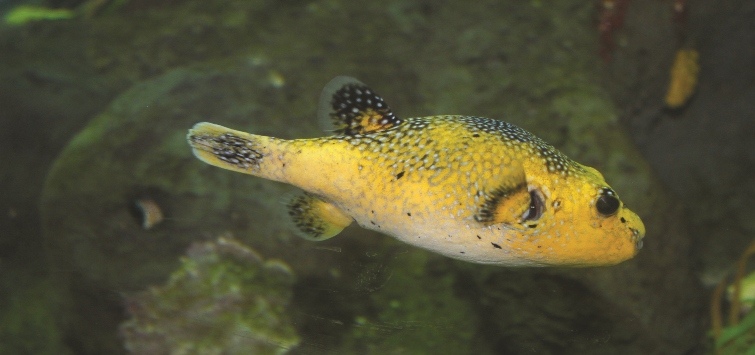Large Saltwater Pufferfish for Big Tanks
Author: Mark Denaro
Puffers are highly intelligent and make great aquarium occupants. Their behavior is interesting to observe, and they can interact with their keepers. As they go about their business in their tank, you can see their intelligence in action as they observe a situation and seem to consider various courses of action before deciding what to do.
No matter what your interest or experience level, there is a puffer for you. Whether you’re keeping freshwater, brackish, or marine aquariums, from nano to gigantic, there is a puffer species (or several) that would suit your setup.
While future articles will cover some of the smaller and even freshwater varieties, our first focus will be on some of the larger saltwater pufferfishes, a group that includes some of the better-known species.
Large Puffers in the Aquarium
As a group, the larger puffers have voracious appetites. They will greedily accept any meaty food. Frozen and fresh foods should constitute the bulk of the diet. High-quality pellets can be used to round it out and ensure that the fish receive enough vitamins. A large food intake means a lot of waste, so it’s important to carefully consider aquarium filtration when setting up their fish tank. Efficient, oversized filters are in order.
Puffers are aggressive enough at feeding time that their tankmates must be chosen with care. Shy or delicate feeders may not fare well with them. Larger angels, tangs, wrasses, lionfish, triggers, and groupers are all great choices. Butterflies might work, but they must be robust species that feed well, and they should be established in the tank before more aggressive eaters are added.
Porcupine Puffers

The world’s most recognizable puffers are members of the genus Diodon. These are the porcupine puffers, and there are species found in tropical waters the world over. Identifying the ones that are available to you can be difficult. The majority of the porcupine puffers in the aquarium trade hail from Florida and the Caribbean, the Philippines, or Indonesia.
The three most common are found throughout much of the world, with Diodon holocanthus probably being the most common in the hobby. It is circumtropical and usually collected from the Florida Keys and Haiti, but it also reaches us from the Philippines and Indonesia. D. hystrix and D. liturosus are regularly available as well, and both also have exceptionally large natural ranges.
Porcupines are the quintessential saltwater pufferfish, recognizable by almost everyone, not just aquarists. Dried specimens are quite popular in the curio trade. I’m convinced that D. holocanthus was Steven Spielberg’s model for E.T.’s face, so much so that I can’t see any other possibility. If it wasn’t intentional, it’s a heck of a coincidence.
Once acclimated to the aquarium, all three species are exceptionally hardy and tend to be long-lived. All are light brown with large, darker irregular brown spots, and all are covered in spines. The face is a bit different, with the mouth extending farther out in D. holocanthus. The three can grow to lengths of at least 24 inches (61 cm), so large tanks are a must. It’s not unusual for hobbyists to start them out in smaller tanks, but they are likely to outgrow these over time. Porcupines will feed voraciously on anything they think might be edible.
Dogfaced Puffers

Arothron nigropunctatus, the dogfaced puffer, is one of the most popular puffers in the hobby. The color pattern is highly variable and features black spots on a gray background, with the number and size of the black spots differing greatly from one individual to the next. This does not seem to be a geographic variation but rather variability in the species. There is also a yellow variant, which is not as common but is even more sought after. Yet, it is the face that so often attracts aquarists to this species and gives them their common name.
They typically reach the aquarium trade at about 6 inches (15 cm), though they are sometimes collected at about 4 inches (10 cm) in length. They usually grow to about 9 inches (23 cm) in the aquarium, though they can reach 13 inches (33 cm) in the wild. Still, this really means a minimum tank of 75 gallons (about 300 liters), and that’s pushing the limit. A tank of 180 gallons or more (about 680 liters) would be better.
In the wild A. nigropunctatus is widespread, ranging from the eastern coast of Africa throughout the Indian and Pacific oceans all the way to Hawaii, and from Australia north to southern Japan.
Dogfaced puffers are delightful aquarium inhabitants and will charm aquarists from the time they first see them in the store. They are inquisitive and always aware of their surroundings, and that includes everything happening outside the aquarium, so you can be sure they check out the customers in the aquarium shop. Indeed, puffers seem to choose their new owners as much as the humans are choosing their puffers.
In the Red Sea, dogfaced puffers are replaced by the masked puffer, A. diadematus. The likelihood is that they were one species at some point in the past, and the two have developed into separate species since they’ve become separated. Interestingly, the color pattern of the masked puffer is much more consistent from individual to individual. They’re also slightly smaller, reaching 12 inches (30 cm) in the wild.
Stars and Stripes Puffers
The stars and stripes pufferfish (A. hispidus), also known as the white-spotted puffer, is another highly variable species. It features a brown base with a pattern of white spots and white lines. No two individuals look alike. They are broad ranging and can be found from the eastern coast of Africa to the western coast of North America.
They are larger, potentially reaching 18 inches (45 cm) in the wild but more typically growing to about 12 inches (30 cm) in the aquarium. Due to this size, the minimum tank for this species should really be 180 gallons.
Mappa Puffers
Mappa puffers (A. mappa) are particularly attractive, featuring squiggly lines emanating from the eye in a very interesting pattern. These lines continue all over the body, somewhat resembling lines on a map. I like to think of them giving each fish its unique fingerprint. While mappa puffers have a broad range, it is not quite as broad as most of the previous species, ranging only from the eastern coast of Africa through the western Pacific. It’s not as common in the trade as most of the other species, and it is highly sought after by experienced hobbyists.
This is one of the most beautiful of the saltwater pufferfishes, but it is not suitable for everyone. It’s a bit more sensitive and should be quarantined for a minimum of a month before being added to a display aquarium.
During this time, it’s important to make sure that the fish is eating well. This species can be reticent to feed in captivity. If your fish doesn’t want to accept prepared foods, offer live ghost shrimp and clams or mussels on the half shell. If it still won’t eat, try offering fresh calamari (but not breaded and fried—that only works to get the TFH crew to begin feeding!).
If none of these are accepted, you’ll want to give serious thought to treating the fish for intestinal parasites or worms. It can be useful to decrease the salinity. Sometimes this triggers feeding, but it doesn’t always work. Be sure that your mappa puffer is feeding well on prepared frozen foods and pellets before adding it to the display tank. If this takes longer than your typical fish quarantine time, so be it. The end results justify the time spent in quarantine. Rushing the fish is a recipe for a poor outcome.
The rarity of mappa puffers in the trade combined with their attractive pattern means that they command a higher price than the previously mentioned species. They have the potential to reach 26 inches (66 cm) in length. Even a small specimen should be kept in a large aquarium, as it will rapidly outgrow most aquariums. For long-term maintenance, a 300-gallon (about 1,200-liter) or larger aquarium will be required.
It’s important to remember that for quarantine, too. If the quarantine tank is too small, the fish will be cramped and stressed. Efficient filtration is necessary to maintain the highest possible water quality.
Guinea Fowl Puffers

A. meleagris, the guinea fowl puffer, is the pièce de résistance of this group, as it is the most colorful. It’s also the only one that is sexually dimorphic. Juveniles and females are black with small white spots. Adult males are a beautiful gold. As a centerpiece for a large aquarium, it is difficult to beat. The combination of its natural beauty, its bold and inquisitive nature, and the potential to add a pair sets it apart.
Its range extends from the eastern coast of Africa to the western coast of North and South America. It most commonly reaches the trade from Costa Rica but is also occasionally imported from Kenya and sometimes other locations.
This is another larger species, reaching 20 inches (50 cm) in the wild. While it is sensitive to shipping and can arrive stressed, it will generally recover. An extended quarantine is recommended with this puffer, too. Because of the aggression and dominance level of its tankmates, it must be in condition to compete for food and territory when added to the display aquarium.
Crowd Favorites
The big saltwater pufferfishes are commonly seen in public and commercial display aquariums for a variety of reasons. They’re big, attractive, bold fish that are interested in everything that happens around them, whether inside or outside the aquarium. Their inquisitive nature ensures that they are a crowd pleaser.
While large puffers aren’t for everyone, they make wonderful additions to the right aquarium. If you have a big tank that will house them correctly, they may well become your favorite fish.
See the full article on TFH Digital
https://www.tfhdigital.com/tfh/nov_dec_2021/MobilePagedReplica.action?pm=2&folio=50#pg53

.png?h=595&iar=0&w=2781&hash=5FD5E69473BCC22199FBFA2FB71B6033)



